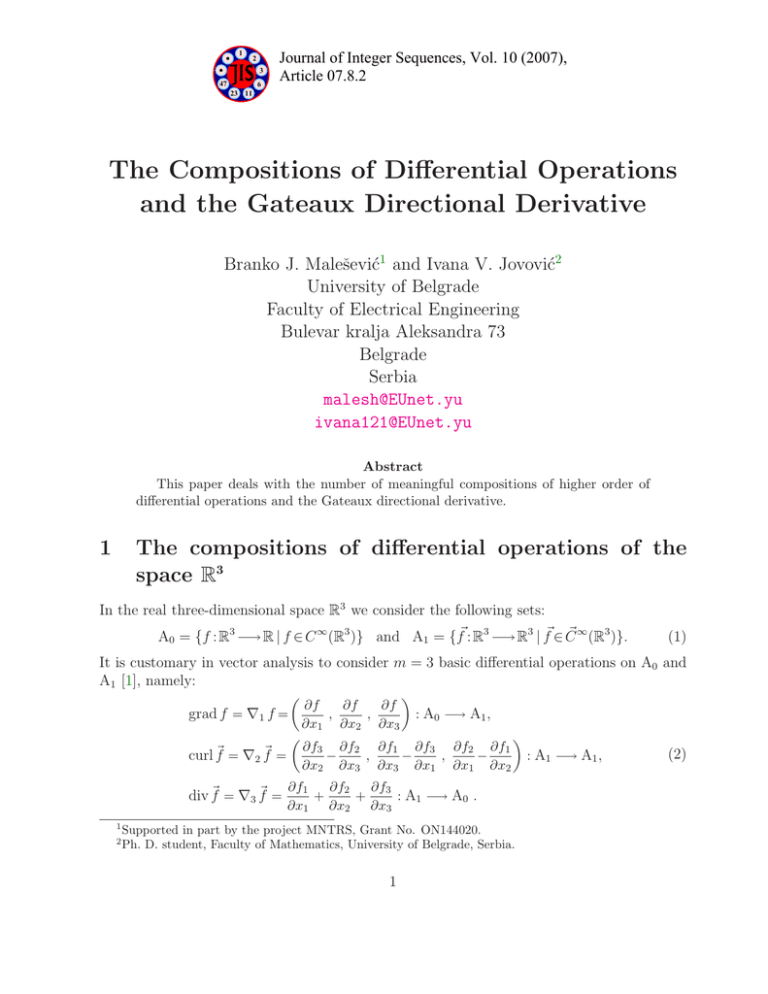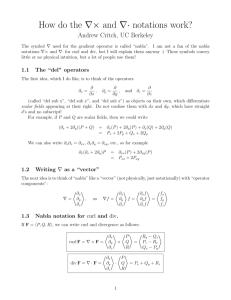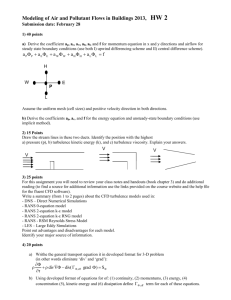The Compositions of Differential Operations and the Gateaux Directional Derivative
advertisement

1
2
3
47
6
Journal of Integer Sequences, Vol. 10 (2007),
Article 07.8.2
23 11
The Compositions of Differential Operations
and the Gateaux Directional Derivative
Branko J. Malešević1 and Ivana V. Jovović2
University of Belgrade
Faculty of Electrical Engineering
Bulevar kralja Aleksandra 73
Belgrade
Serbia
malesh@EUnet.yu
ivana121@EUnet.yu
Abstract
This paper deals with the number of meaningful compositions of higher order of
differential operations and the Gateaux directional derivative.
1
The compositions of differential operations of the
space R3
In the real three-dimensional space R3 we consider the following sets:
~ ∞ (R3 )}.
A0 = {f : R3 −→ R | f ∈ C ∞ (R3 )} and A1 = {f~ : R3 −→ R3 | f~ ∈ C
(1)
It is customary in vector analysis to consider m = 3 basic differential operations on A0 and
A1 [1], namely:
∂f
∂f
∂f
grad f = ∇1 f =
: A0 −→ A1 ,
,
,
∂x1 ∂x2 ∂x3
∂f3 ∂f2 ∂f1 ∂f3 ∂f2 ∂f1
~
~
: A1 −→ A1 ,
−
,
−
,
−
curl f = ∇2 f =
∂x2 ∂x3 ∂x3 ∂x1 ∂x1 ∂x2
div ~f = ∇3 ~f =
1
2
∂f1
∂f2
∂f3
+
+
: A1 −→ A0 .
∂x1 ∂x2 ∂x3
Supported in part by the project MNTRS, Grant No. ON144020.
Ph. D. student, Faculty of Mathematics, University of Belgrade, Serbia.
1
(2)
Let us present the number of meaningful compositions of higher order over the set A3 =
{∇1 , ∇2 , ∇3 }. It is familiar fact that there are m = 5 compositions of the second order [2,
p. 161]:
∆f = div grad f = ∇3 ◦ ∇1 f,
curl curl f~ = ∇2 ◦ ∇2 f~,
grad div f~ = ∇1 ◦ ∇3 f~,
(3)
curl grad f = ∇2 ◦ ∇1 f = ~0,
div curl f~ = ∇3 ◦ ∇2 f~ = 0.
Malešević [3] proved that there are m = 8 compositions of the third order:
grad div grad f = ∇1 ◦ ∇3 ◦ ∇1 f,
curl curl curl f~ = ∇2 ◦ ∇2 ◦ ∇2 f~,
div grad div f~ = ∇3 ◦ ∇1 ◦ ∇3 f~,
curl curl grad f = ∇2 ◦ ∇2 ◦ ∇1 f = ~0,
div curl grad f = ∇3 ◦ ∇2 ◦ ∇1 f = 0,
(4)
div curl curl f~ = ∇3 ◦ ∇2 ◦ ∇2 f~ = 0,
grad div curl f~ = ∇1 ◦ ∇3 ◦ ∇2 f~ = ~0,
curl grad div f~ = ∇2 ◦ ∇1 ◦ ∇3 f~ = ~0.
If f(k) is the number of compositions of the k th order, then Malešević [4] proved
f(k) = Fk+3 ,
(5)
where Fk is k th Fibonacci number.
2
The compositions of the differential operations and
Gateaux directional derivative of the space R3
Let f ∈ A0 be a scalar function and ~e = (e1 , e2 , e3 ) ∈ R3 be a unit vector. The Gateaux
directional derivative in direction ~e is defined by [5, p. 71]:
dir~e f = ∇0 f = ∇1 f · ~e =
∂f
∂f
∂f
e1 +
e2 +
e3 : A0 −→ A0 .
∂x1
∂x2
∂x3
2
(6)
Let us determine the number of meaningful compositions of higher order over the set B3 =
{∇0 , ∇1 , ∇2 , ∇3 }. There exist m = 8 compositions of the second order:
dir~e dir~e f = ∇0 ◦ ∇0 f = ∇1 ∇1 f · ~e · ~e,
grad dir~e f = ∇1 ◦ ∇0 f = ∇1 ∇1 f · ~e ,
∆f = div grad f = ∇3 ◦ ∇1 f,
curl curl f~ = ∇2 ◦ ∇2 f~,
dir~e div f~ = ∇0 ◦ ∇3 f~ = ∇1 ◦ ∇3 f~ · ~e,
(7)
grad div f~ = ∇1 ◦ ∇3 f~,
curl grad f = ∇2 ◦ ∇1 f = ~0,
div curl f~ = ∇3 ◦ ∇2 f~ = 0;
and there exist m = 16 compositions of the third order:
dir~e dir~e dir~e f = ∇0 ◦ ∇0 ◦ ∇0 f,
grad dir~e dir~e f = ∇1 ◦ ∇0 ◦ ∇0 f,
div grad dir~e f = ∇3 ◦ ∇1 ◦ ∇0 f,
dir~e div grad f = ∇0 ◦ ∇3 ◦ ∇1 f,
grad div grad f = ∇1 ◦ ∇3 ◦ ∇1 f,
curl curl curl f~ = ∇2 ◦ ∇2 ◦ ∇2 f~,
dir~e dir~e div f~ = ∇0 ◦ ∇0 ◦ ∇3 f~,
grad dir~e div f~ = ∇1 ◦ ∇0 ◦ ∇3 f~,
div grad div f~ = ∇3 ◦ ∇1 ◦ ∇3 f~,
curl grad dir~e f = ∇2 ◦ ∇1 ◦ ∇0 f~ = ~0,
curl curl grad f = ∇2 ◦ ∇2 ◦ ∇1 f = ~0,
div curl grad f = ∇3 ◦ ∇2 ◦ ∇1 f = 0,
div curl curl f~ = ∇3 ◦ ∇2 ◦ ∇2 f~ = 0,
dir~e div curl f~ = ∇0 ◦ ∇3 ◦ ∇2 f~ = 0,
grad div curl f~ = ∇1 ◦ ∇3 ◦ ∇2 f~ = ~0,
curl grad div f~ = ∇2 ◦ ∇1 ◦ ∇3 f~ = ~0.
3
(8)
Further on we shall use the method from the paper [4]. Let us define a binary relation σ “to
be in composition”: ∇i σ ∇j iff the composition ∇j ◦ ∇i is meaningful. Then Cayley table of
the relation σ is determined by
σ ∇0 ∇1 ∇2 ∇3
∇0 ⊤ ⊤ ⊥ ⊥
∇1 ⊥ ⊥ ⊤ ⊤
∇2 ⊥ ⊥ ⊤ ⊤
∇3 ⊤ ⊤ ⊥ ⊥
(9)
Let us denote by ∇−1 nowhere-defined function, where domain and range are empty sets [3]
and let ∇−1 σ ∇i hold for i = 0, 1, 2, 3. If G is graph which is determined by the relation σ,
then graph of paths of G is the tree with the root ∇−1 (Fig. 1).
∇0
q
A
q∇−1
`
H
H````
HH
```
∇0
∇1 ``` ∇
q
q
H∇
q 2
q 3
@
@
@
@
@
@
@
@
∇2
@∇
q 1 ∇q2
@∇q 3
@∇
q
q 3 ∇q0
@∇
q 1
A A
A
A
A A
A
g(0) =
1
g(1) =
4
g(2) =
g(3) =
8
16
Fig. 1
Let g(k) be the number of meaningful compositions of the k th order of the functions from B3
and let gi (k) be the number of meaningful compositions of the k th order beginning from the
left by ∇i . Then g(k) = g0 (k) + g1 (k) + g2 (k) + g3 (k). Based on the partial self similarity
of the tree (Fig. 1) we obtain equalities
g0 (k) = g0 (k − 1) + g1 (k − 1),
g1 (k) = g2 (k − 1) + g3 (k − 1),
g2 (k) = g2 (k − 1) + g3 (k − 1),
(10)
g3 (k) = g0 (k − 1) + g1 (k − 1).
Hence, the recurrence for g(k) is
g(k) = 2 g(k − 1)
(11)
g(k) = 2k+1 .
(12)
and because g(1) = 4 we have
3
The compositions of differential operations of the
space Rn
Let us present the number of meaningful compositions of differential operations in the vector
analysis of the space Rn , where differential operations ∇r (r = 1, . . . , n) are defined on
4
corresponding non-empty sets As (s = 1, . . . , m and m = ⌊n/2⌋, n ≥ 3) according to the
papers [4], [6]:
An (n = 2m+1): ∇1 : A0 → A1
∇ 2 : A1 → A 2
An (n = 2m): ∇1 : A0 → A1
∇ 2 : A1 → A 2
..
.
..
.
∇i : Ai−1 → Ai
∇i : Ai−1 → Ai
..
.
..
.
∇m : Am−1 → Am
∇m+1 : Am → Am
∇m+2 : Am → Am−1
∇m : Am−1 → Am
∇m+1 : Am → Am−1
..
.
(13)
..
.
∇n−j : Aj+1 → Aj
∇n−j : Aj+1 → Aj
..
.
..
.
∇n−1 : A2 → A1
∇ n : A1 → A 0 ,
∇n−1 : A2 → A1
∇ n : A1 → A 0 .
Let us define higher order differential operations as meaningful compositions of higher order
of differential operations from the set An = {∇1 , . . . , ∇n }. The number of higher order
differential operations is given according to the paper [4]. Furthermore, let us define a
binary relation ρ “to be in composition”: ∇i ρ ∇j iff the composition ∇j ◦ ∇i is meaningful.
Then Cayley table of the relation ρ is determined by
(
⊤ , (j = i + 1) ∨ (i + j = n + 1);
(14)
∇i ρ ∇j =
⊥ , otherwise.
Let A = [aij ] ∈ { 0, 1}n×n be the adjacency matrix associated with the graph which is
determined by the relation ρ. Malešević [6] proved the following statements.
Theorem 3.1. Let Pn (λ) = |A−λI| = α0 λn +α1 λn−1 +· · ·+αn be the characteristic polynomial
of the matrix A and vn = [ 1 . . . 1 ]1×n . If f(k) is the number of the k th order differential
operations, then the following formulas hold:
f(k) = vn · Ak−1 · vnT
(15)
α0 f(k) + α1 f(k − 1) + · · · + αn f(k − n) = 0 (k > n).
(16)
and
5
Lemma 3.2. Let Pn (λ) be the characteristic polynomial of the matrix A. Then the following
recurrence holds:
Pn (λ) = λ2 Pn−2 (λ) − Pn−4 (λ) .
(17)
Lemma 3.3. Let Pn (λ) be the characteristic polynomial of the matrix A. Then it has the
following explicit form:
⌊ n+2
⌋+1
n
4
X
−k+2
k−1
2
(−1)
λn−2k+2
, n = 2m;
k−1
k=1
Pn (λ) = ⌊ n+2 ⌋+2
(18)
n+3 n+3 !
4
X
−k
−k
2
2
(−1)k−1
+
λ λn−2k+2 , n = 2m+1.
k−1
k−2
k=1
From previous statements one can obtain the recurrences in the table, [4]:
Dimension
n= 3
n= 4
n= 5
n= 6
n= 7
n= 8
n= 9
n = 10
Recurrence for the number of the k th order differential operations
f(k) = f(k − 1) + f(k − 2)
f(k) = 2f(k − 2)
f(k) = f(k − 1) + 2f(k − 2) − f(k − 3)
f(k) = 3f(k − 2) − f(k − 4)
f(k) = f(k − 1) + 3f(k − 2) − 2f(k − 3) − f(k − 4)
f(k) = 4f(k − 2) − 3f(k − 4)
f(k) = f(k − 1) + 4f(k − 2) − 3f(k − 3) − 3f(k − 4) + f(k − 5)
f(k) = 5f(k − 2) − 6f(k − 4) + f(k − 6)
The values of the function f(k), for small values of the argument k, are given in the database
of integer sequences [8] as the following sequences A020701 (n = 3), A090989 (n = 4),
A090990 (n = 5), A090991 (n = 6), A090992 (n = 7), A090993 (n = 8), A090994 (n = 9),
A090995 (n = 10).
4
The compositions of differential operations and Gateaux
directional derivative of the space Rn
Let f ∈ A0 be a scalar function and ~e = (e1 , . . . , en ) ∈ Rn be a unit vector. The Gateaux
directional derivative in direction ~e is defined by [5, p. 71]:
dir~e f = ∇0 f =
n
X
∂f
ek : A0 −→ A0 .
∂x
k
k=1
6
(19)
Let us extend the set of differential operations An = {∇1 , . . . , ∇n } with Gateaux directional
derivative to the set Bn = An ∪ {∇0 } = {∇0 , ∇1 , . . . , ∇n }:
B n (n = 2m+1): ∇0 : A0 → A0
∇ 1 : A 0 → A1
∇ 2 : A 1 → A2
B n (n = 2m): ∇0 : A0 → A0
∇ 1 : A0 → A 1
∇ 2 : A1 → A 2
..
.
..
.
∇i : Ai−1 → Ai
∇i : Ai−1 → Ai
..
.
..
.
∇m : Am−1 → Am
∇m+1 : Am → Am
∇m+2 : Am → Am−1
∇m : Am−1 → Am
∇m+1 : Am → Am−1
..
.
(20)
..
.
∇n−j : Aj+1 → Aj
∇n−j : Aj+1 → Aj
..
.
..
.
∇n−1 : A2 → A1
∇ n : A1 → A 0 ,
∇n−1 : A2 → A1
∇ n : A1 → A 0 .
Let us define higher order differential operations with Gateaux derivative as the meaningful
compositions of higher order of the functions from the set Bn = {∇0 , ∇1 , . . . , ∇n }. Our aim
is to determine the number of higher order differential operations with Gateaux derivative.
Let us define a binary relation σ “to be in composition”:
(
⊤ , (i = 0 ∧ j = 0) ∨ (i = n ∧ j = 0) ∨ (j = i+1) ∨ (i+j = n+1);
∇i σ ∇j =
(21)
⊥ , otherwise.
and let B = [bij ] ∈ { 0, 1}(n+1)×n be the adjacency matrix associated with the graph which is
determined by relation σ. So, analogously to the paper [6], the following statements hold.
Theorem 4.1. Let Qn (λ) = |B − λI| = β0 λn+1 + β1 λn + · · · + βn+1 be the characteristic
polynomial of the matrix B and vn+1 = [ 1 . . . 1 ]1×(n+1) . If g(k) is the number of the k th order
differential operations with Gateaux derivative, then the following formulas hold:
T
g(k) = vn+1 · Bk−1 · vn+1
(22)
and
β0 g(k) + β1 g(k − 1) + · · · + βn+1 g(k − (n + 1)) = 0
(k > n+1).
Lemma 4.2. Let Qn (λ) and Pn (λ) be the characteristic polynomials of the matrices
A respectively. Then the following equality holds:
Qn (λ) = λ2 Pn−2 (λ) − λPn (λ).
7
(23)
B and
(24)
Proof. Let us calculate the characteristic polynomial
1−λ
1
0
−λ
0
0
.
..
..
Qn (λ) = |B − λI| = .
0
0
0
0
1
1
0 0
1 0
−λ 1
.. ..
. .
0 1
1 0
0 0
...
...
...
..
.
0
0
0
..
.
0
0
0
..
.
...
...
...
0 −λ
0
0
0
0
Expanding the determinant Qn (λ) by the first column we have
.
1
0 −λ
1 0 −λ 0
0
1
..
.
Qn (λ) = (1 − λ)Pn (λ) + (−1)n+2 Dn (λ),
0
1
0
..
.
(25)
(26)
where
1
−λ
0
Dn (λ) = ...
0
0
0
0 0
1 0
−λ 1
.. ..
. .
0 0
0 1
1 0
1
−λ
0
Dn (λ) = ...
0
0
0
0 0
1 0
−λ 1
.. ..
. .
0 1
1 0
0 0
0 ...
0 ...
0 ...
.. . .
.
.
1 ...
0 ...
0 ...
0
0
0
..
.
−λ
0
0
0 0 0 1 1 0 .. .. .
. . 1
0 0 −λ
1 0 0 −λ 1 0
0
0
..
.
(27)
Let us expand the determinant Dn (λ) by the first row and then in the next step, multiply
the first row by −1 and add it to the last row. We obtain the determinant of order n − 1 :
0 ...
0 ...
0 ...
.. . .
.
.
0 ...
0 ...
0 ...
0
0
0
..
.
−λ
0
0
0 1 1 0 0 0 .. .. .
. . 1
0 0 −λ
1 0 0 −λ 0 0
0
1
..
.
(28)
Expanding the previous determinant by the last column we have
−λ
0
0
n
Dn (λ) = (−1) ...
0
0
0
1
0
−λ
1
0 −λ
..
..
.
.
0
1
1
0
0
0
8
0 ...
0 ...
1 ...
.. . .
.
.
0 ...
0 ...
0 ...
0
0
0
..
.
0
0
0
.
−λ
1
0 0 −λ
1 0
0 −λ 0
0
1
..
.
0
1
0
..
.
1
0
0
..
.
(29)
If we expand the previous determinant by the last row and if we expand the obtained
determinant by the first column, we have the determinant of order n − 4 :
In other words
−λ
1
0 −λ
0
0
n 2
.
..
Dn (λ) = (−1) λ ..
.
0
0
0
1
1
0
0 0
1 0
−λ 1
.. ..
. .
1 0
0 0
0 0
...
...
...
..
.
0
0
0
..
.
0
0
1
..
.
...
...
...
0 −λ
0
0
0
0
.
1
0 −λ
1 0 −λ 0
1
0
..
.
1
0
0
..
.
Dn (λ) = (−1)n λ2 Pn−4 (λ).
(30)
(31)
From equalities (31) and (26) there follows:
Qn (λ) = (1 − λ)Pn (λ) + λ2 Pn−4 (λ).
(32)
On the basis of Lemma 3.2. the following equality holds:
Qn (λ) = λ2 Pn−2 (λ) − λPn (λ).
(33)
Lemma 4.3. Let Qn (λ) be the characteristic polynomial of the matrix B. Then the following
recurrence holds:
Qn (λ) = λ2 Qn−2 (λ) − Qn−4 (λ) .
(34)
Proof. On the basis of Lemma 3.2. and Lemma 4.2. the Lemma follows.
Lemma 4.4. Let Qn (λ) be the characteristic polynomial of the matrix B. Then it has the
following explicit form:
⌊ 4n⌋+1
n+1
X
−k
k−1
2
(λ − 2)
(−1)
λn−2k+2
, n = 2m+1;
k−1
k=1
(35)
Qn (λ) = n+3
⌊ 4 ⌋+2
n
n
!
X
−k+2
−k+2
2
(−1)k−1
+ 2
λ λn−2k+3 , n = 2m.
k−1
k−2
k=1
Proof. On the basis of Lemma 3.3 and Lemma 4.2. the Lemma follows.
The recurrences for dimensions n = 3, 4, . . . , 10 are obtained by means of MaleševićJovović [7] and they are given in the table below.
9
Dimension Recurrence for the num. of the k th order diff. operations with Gateaux derivative
n= 3
n= 4
n= 5
n= 6
n= 7
n= 8
n= 9
n =10
g(k) = 2g(k − 1)
g(k) = g(k − 1) + 2g(k − 2) − g(k − 3)
g(k) = 2g(k − 1) + g(k − 2) − 2g(k − 3)
g(k) = g(k − 1) + 3g(k − 2) − 2g(k − 3) − g(k − 4)
g(k) = 2g(k − 1) + 2g(k − 2) − 4g(k − 3)
g(k) = g(k − 1) + 4g(k − 2) − 3g(k − 3) − 3g(k − 4) + g(k − 5)
g(k) = 2g(k − 1) + 3g(k − 2) − 6g(k − 3) − g(k − 4) + 2g(k − 5)
g(k) = g(k − 1) + 5g(k − 2) − 4g(k − 3) − 6g(k − 4) + 3g(k − 5) + g(k − 6)
The values of the function g(k), for small values of the argument k, are given in the database
of integer sequences [8] as the following sequences A000079 (n = 3), A090990 (n = 4),
A007283 (n = 5), A090992 (n = 6), A000079 (n = 7), A090994 (n = 8), A020714 (n = 9),
A129638 (n = 10).
References
[1] Ivanov, A. B., Vector analysis, in M. Hazewinkel, ed., Encyclopaedia of Mathematics,
Springer, 2002. Text available at http://eom.springer.de/V/v096360.htm.
[2] G. A. Korn and T. M. Korn, Mathematical Handbook for Scientists and Engineers: Definitions, Theorems, and Formulas for Reference and Review, Courier Dover Publications,
2000.
[3] B. J. Malešević, A note on higher-order differential operations, Univ. Beograd,
Publ. Elektrotehn. Fak., Ser. Mat. 7 (1996), 105–109. Text available at
http://pefmath2.etf.bg.ac.yu/files/116/846.pdf.
[4] B. J. Malešević, Some combinatorial aspects of differential operation composition on
the space Rn , Univ. Beograd, Publ. Elektrotehn. Fak., Ser. Mat. 9 (1998), 29–33. Text
available at http://pefmath2.etf.bg.ac.yu/files/118/869.pdf.
[5] S. Basov, Multidimensional Screening, Springer 2005.
[6] B. J. Malešević, Some combinatorial aspects of the composition of a set
of function, Novi Sad J. Math., 36 (1), 2006, 3–9. Text available at
http://www.im.ns.ac.yu/NSJOM/Papers/36 1/NSJOM 36 1 003 009.pdf.
[7] B. J. Malešević and I. V. Jovović, A procedure for finding the k th power of a matrix.
http://www.maplesoft.com/Applications.
[8] N. J. A. Sloane,
The On-Line Encyclopedia
http://www.research.att.com/~njas/sequences/.
10
of
Integer
Sequences.
2000 Mathematics Subject Classification: 05C30, 26B12, 58C20.
Keywords: compositions of the differential operations, enumeration of graphs and maps,
Gateaux directional derivative.
(Concerned with sequences A000079, A007283, A020701, A020714, A090989, A090990, A090991,
A090992, A090993, A090994, A090995, and A129638.)
Received June 5, 2007; revised version received July 30, 2007. Published in Journal of Integer
Sequences, August 3 2007.
Return to Journal of Integer Sequences home page.
11






